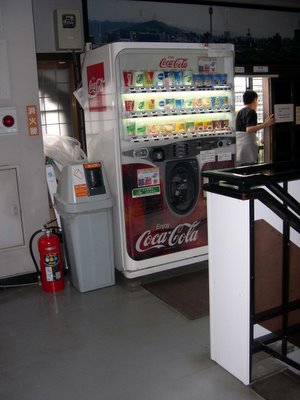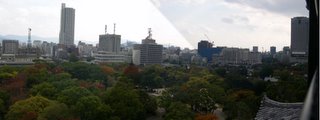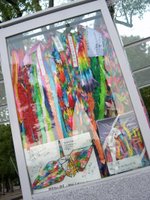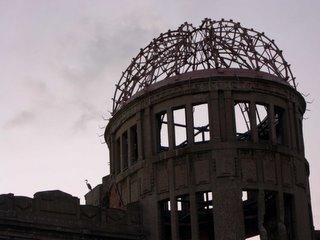 right after ise, i went back to the dohokan to get ready for my trip to hiroshima. as i layed in bed, i started going over my plans for the next day: i was goign to be staying over night at a ryokan in hiroshima and then heading over to miyajima the next day. it was weird, i had all of these reservations about traveling alone, like fearing for my safety, and stuff like that, but all of the excitiment about seeing stuff around japan just made those feelings dissappated. in a way i felt really empowered. i was totally taking charge of what i was going to do, what i was going to see and really without the help of anybody. i think this was one of the first times that i've done this travelwise. usually, i've been more layed back and just went with the flow of things. wow, i'm kinda amazed at myself right now. (alright i'll stop patting myself of the back.) i think if this was someplace else, it would totally be different. i'd seriously be that deer in the headlights.
right after ise, i went back to the dohokan to get ready for my trip to hiroshima. as i layed in bed, i started going over my plans for the next day: i was goign to be staying over night at a ryokan in hiroshima and then heading over to miyajima the next day. it was weird, i had all of these reservations about traveling alone, like fearing for my safety, and stuff like that, but all of the excitiment about seeing stuff around japan just made those feelings dissappated. in a way i felt really empowered. i was totally taking charge of what i was going to do, what i was going to see and really without the help of anybody. i think this was one of the first times that i've done this travelwise. usually, i've been more layed back and just went with the flow of things. wow, i'm kinda amazed at myself right now. (alright i'll stop patting myself of the back.) i think if this was someplace else, it would totally be different. i'd seriously be that deer in the headlights.anyways so i had bags packed and headed for kyoto station to catch the shinkansen to hiroshima the next morning. on my intinerary were to see these gardens, hiroshima castle and check-in at my ryokan before hitting the big things in town like the a-bomb park.

Hiroshima Castle. This tower was used to watch for approaching enemies.
 This is what they had at the top of the castle, just like in the old days!
This is what they had at the top of the castle, just like in the old days!
 View from the top of the castle.
View from the top of the castle.
i really wanted to see how people who went through such a tragedy and turn it into something positive. as i passed the a-bomb dome on my way to my ryokan my heart sank alittle bit. i was mere meters away from when this blast had occured that not only killed people, but had such resonnating affect on future generations of people. This is what they had at the top of the castle, just like in the old days!
This is what they had at the top of the castle, just like in the old days! View from the top of the castle.
View from the top of the castle. 
 walking through the musuem i couldn't help but stand in disbelief at the before and after pictures of hiroshima. these feelings stemmed partly realizing what had been going at that time and from this sad violin music that was playing in the background that echoed through the first section of the museum. there were japanese school children that filled the area along with many americans who were holding handkerchiefs and wiping their tears as they passed relics of that fateful day.
walking through the musuem i couldn't help but stand in disbelief at the before and after pictures of hiroshima. these feelings stemmed partly realizing what had been going at that time and from this sad violin music that was playing in the background that echoed through the first section of the museum. there were japanese school children that filled the area along with many americans who were holding handkerchiefs and wiping their tears as they passed relics of that fateful day.the most touching part of the musuem were the personal accounts of victims and the lives of the people who lived through the bombing. i can honestly say that i was getting teary eyed walking through this part of the museum. one account that stands out was that of Sadako:
"Sadako was two years old when she was exposed to the A-bomb. She had no apparent injuries and grew into a strong and healthy girl. However, nine years later in the fall when she was in the sixth grade of elementary school (1954), she suddenly developed signs of an illness. In February the following year she was diagnosed with leukemia and was admitted to the Hiroshima Red Cross Hospital. Believing that folding paper cranes would help her recover, she kept folding them to the end, but on October 25, 1955, after an eight-month struggle with the disease, she passed away.
Sadako's death triggered a campaign to build a monument to pray for world peace and the peaceful repose of the many children killed by the atomic bomb. The Children's Peace Monument that stands in Peace Park was built with funds donated from all over Japan. Later, this story spread to the world, and now, approximately 10 million cranes are offered each year before the Children's Peace Monument."
(for more personal accounts: http://www.city.hiroshima.jp/shimin/heiwa/peaceenglish.html)
after finishing the musuem i headed towards the children peace memorial and finally to the a-bomb dome. it was definately a sight to see. the ruins help to serve as a reminder not only for the people, but for the world about the harsh realities for war.




1 comments:
hahaha. stupid advertisers...
anyway. love your photos...
Post a Comment